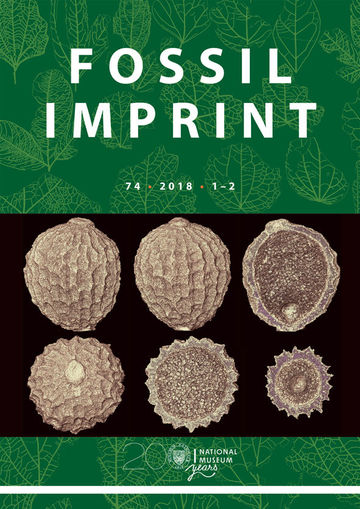
2018/74/1-2
ISSN : 2533-4050 (tisk), 2533-4069 (online)
Vedoucí redaktor : Jiří Kvaček
Vedoucí redaktor : Jiří Kvaček
International conference celebrating Zlatko Kvaček’s contribution to palaeobotany
Jiří Kvaček, Jiřina Dašková
Nomenclatural status of the palaeobotanical “artificial taxa” established in Brongniart’s 1822 “Classification” paper
Christopher J. Cleal, Barry A. Thomas
Brongniart’s 1822 paper “Sur la classification et la distribution des végétaux fossils” was one of the most important early contributions to palaeobotany, especially in its treatment of how to name and classify plant fossils. Twenty four genera / sections were named in this work. Seven of these…
The first report of Cryptocaryoxylon from the Neogene (early Miocene) of Eurasia (Eastern Mediterranean: Lesbos and Lemnos Islands, Greece)
Dimitra Mantzouka
Two specimens of fossil lauraceous woods from the Cainozoic (early Miocene) of Greece (southern part of Lesbos Island and central-eastern part of Lemnos Island) were studied. Their microscopic characteristics revealed two different kinds of fossil lauraceous woods with a different distribution of…
Early occurrence of a Pennsylvanian-age medullosalean frond similar to Alethopteris pseudograndinioides in the intra-montane basin of Bohemia
Zbyněk Šimůnek, Christopher J. Cleal
A single frond fragment found in the lower Bolsovian Substage of Central and Western Bohemia (the Czech Republic) closely resembles Alethopteris pseudograndinioides Zodrow et Cleal, a species not normally seen until rather younger, late Asturian floras. This discovery provides further evidence that…
Trochodendraceous fruits and foliage in the Miocene of western North America
Steven R. Manchester, Kathleen B. Pigg, Melanie L. Devore
Two fossil fruit types and at least one fossil leaf type representing Trochodendraceae are recognized from the middle Miocene Cascadia flora of western Oregon, USA. Trochodendron rosayi sp. nov., known also from the middle Miocene of eastern Oregon and northern Idaho, is based on long-pedicelled,…
Phialopteris heterophylla (Sternberg ex Göppert, 1836) comb. nov., a rare schizaeaceous fern from the Early Jurassic of Bavaria
Johanna H.A. Van Konijnenburg-van Cittert, Christian Pott, Evelyn Kustatscher, Stefan Schmeisser, Günter Dütsch, Johan van der Burgh
Recently collected material of the monotypic schizaeaceous fern genus Phialopteris is described including for the first time the in situ spores. The complex nomenclatural history of the type species is discussed, resulting in the designation of the new combination Phialopteris heterophylla…
Rightcania and Kvacekispermum: Early Cretaceous seeds from eastern North America and Portugal provide further evidence of the early chloranthoid diversification
Else Marie Friis, Peter R. Crane, Kaj Raunsgaard Pedersen
Abundant flowers, fruits, seeds and stamens that are closely related to extant Chloranthaceae have been reported from the Early Cretaceous floras of Portugal. Among these are small berries with endotestal seeds assigned to the extinct genera Canrightia and Canrightiopsis. Here we describe two new…
Quantitative application of the Whole-Plant Concept to the Messinian – Piacenzian flora of Italy
Edoardo Martinetto, Loredana Macaluso
The analysis of a taxonomical database containing Italian pollen and macrofossil records of the Messinian – Piacenzian time interval allowed us to evaluate the possible assemblage of different parts within a Whole-Plant Concept. The fossil plant parts that we deemed more significant were:…
Reappraisal of Greguss’ fossil wood types and figured specimens from the Cenozoic of Hungary: overview, corrected geology and systematical notes
Jakub Sakala, Ildikó Selmeczi, Lilla Hably
Prof. Pál Greguss (*1889, †1984) was a leading figure in European (palaeo)xylotomy. His collection of types and figured specimens from the Cenozoic of Hungary published in the two monographs (Fossil gymnosperm woods in Hungary from the Permian to the Pliocene and Tertiary angiosperm woods in…
The Middle Miocene Central European plant record revisited; widespread subhumid sclerophyllous forests indicated
Johanna Kovar-Eder, Vasilis Teodoridis
The Middle Miocene plant record from the wider Central Paratethys region (Central Paratethys, the North Alpine Foredeep, Carpathian Foredeep, the Swabian Alb and southern parts of the Bohemian Massif) was analysed by the Integrated Plant Record (IPR) vegetation analysis to assess major vegetation…
Extinct taxa of exotestal seeds close to Austrobaileyales and Nymphaeales from the Early Cretaceous of Portugal
Else Marie Friis, Peter R. Crane, Kaj Raunsgaard Pedersen
Early Cretaceous mesofossil floras from Portugal and North America include a surprising diversity of small, bitegmic angiosperm seeds with a hard exotestal seed coat. This study describes six different kinds of these seeds from three Portuguese mesofossil localities; Vale de Agua, Torres Vedras, and…
On the likely palaeoelevation of the Turonian – Coniacian Arman Flora site (North-eastern Asia)
Alexei B. Herman
The Turonian – Coniacian (Late Cretaceous) Arman Flora (North-eastern Russia, Magadan District) exhibits a high diversity of fossil angiosperms (28 dicot species). Based on their physiognomy, palaeoclimate variables were estimated showing that the flora experienced a humid warm-temperate climate…
An angiosperm dominated herbaceous community from the early – middle Albian of Primorye, Far East of Russia
Lina Golovneva, Pavel Alekseev, Eugenia Bugdaeva, Elena Volynets
An extraordinarily well-preserved autochthonous angiosperm herbaceous community is described from the Lower Cretaceous deposits of the Frentsevka Formation, southern Primorye, Far East of Russia. The locality Bolshoy Kuvshin is situated on the coast of the Ussuri Bay on the Bolshoy Kuvshin Cape near…
Stutzeliastrobus bohemicus comb. nov. – basal Cupressaceae conifer from the Cenomanian of the Bohemian Cretaceous Basin, Central Europe
Jiří Kvaček, Zuzana Heřmanová, Jana Bruthansová, Jakub Karch, Jan Žemlička, Jan Dudák
The Cupressaceae conifer Stutzeliastrobus bohemicus (Bayer) J.KvačeK comb. nov. is described from the Cenomanian Peruc-Korycany Formation of the Bohemian Cretaceous Basin. It is characterised by elongate ovuliferous cones with helically arranged thin, bilaterally symmetrical ovuliferous bract-scale…
External morphology of Pinus timleri seed cones from the Neogene of the Lower Rhenish Basin, W Germany
Rolf Gossmann, Philipp L. Knaus
The external morphology of Pinus timleri seed cones is described from exceptionally well preserved cones and cone fragments from the Lower Rhenish Basin (Germany). The seed cones are asymmetric with a smooth side and erect umbos on the apophyses of the other side. We hypothesise that the smooth side…
